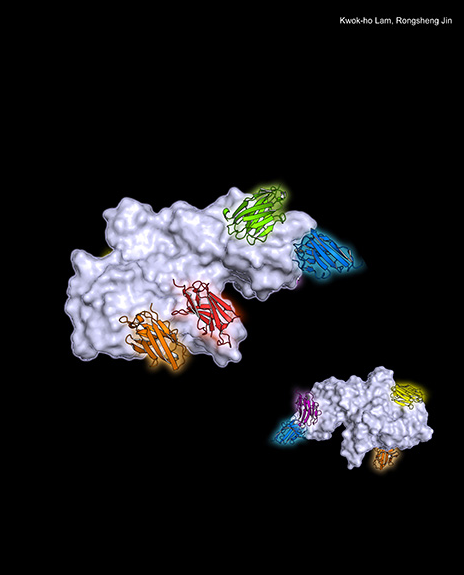Bifunctional nanobodies proven effective at protecting against botulinum neurotoxins including Botox
Source:

The illustration shows six nanobodies (VHHs) bound to botulinum neurotoxin (BoNT). Lam et al. report the crystal structures and neutralizing mechanisms of six unique nanobodies against two major human pathogenic BoNT type A and B. They then develop a platform for structure-based rational design of bifunctional nanobodies with superior antitoxin potencies.
UCI School of Medicine
Irvine, CA. – February 27, 2020
ew study reveals potential for developing novel antibody-based antitoxins against botulinum neurotoxins (BoNTs), including the most commonly used, yet most toxic one, Botox.
Published in Cell Reports, the paper is titled, “Structural insights into rational design of single-domain antibody-based antitoxins against botulinum neurotoxins.” Led by Rongsheng Jin, PhD, a professor in the Department of Physiology & Biophysics at the University of California, Irvine, School of Medicine, this paper describes how the team first identified the neutralizing epitopes of six anti-BoNT nanobodies (VHHs) based on their crystal structures, then harnessed the structural findings to rationally design bifunctional nanobodies. Different than ordinary nanobodies, bifunctional nanobodies are composed of two nanobodies that bind simultaneously to the toxins.
Based on a mouse model, their findings revealed the bifunctional nanobodies protected mice with much greater potency than the simple combination of two nanobodies.
“In a nutshell, we establish a platform for structure-based rational design of bifunctional antitoxins against BoNTs,” said Kwok-ho Lam, the first author and a project scientist in the Jin lab. “BoNTs can be misused as a bioweapon and thus have been classified as Tier 1 select agents by the Centers for Disease Control and Prevention, which is why there is urgent need for antitoxins.”
Ironically, Botox is a type A botulinum neurotoxin (BoNT/A), and just one of the many different types of botulinum neurotoxins. BoNT/B is another botulinum neurotoxin approved for therapeutic uses, and yet another type, BoNT/E, is in clinical trials.
“Currently, the only available antitoxin remedies are polyclonal antibodies from horse or human serum, which have known health risks and are in limited supply. Monoclonal antibodies are still under development,” said Jin. “And, while it isn’t necessarily a cause for worry, the increasingly popular therapeutic uses of BoNT products also create risks of possible botulism resulting from the medical treatments where they are used.”
This study was funded in part by the National Institute of Allergy and Infectious Diseases, the Defense Threat Reduction Agency—Chemical Biological Defense Therapeutics, and the National Institute of General Medical Sciences.
